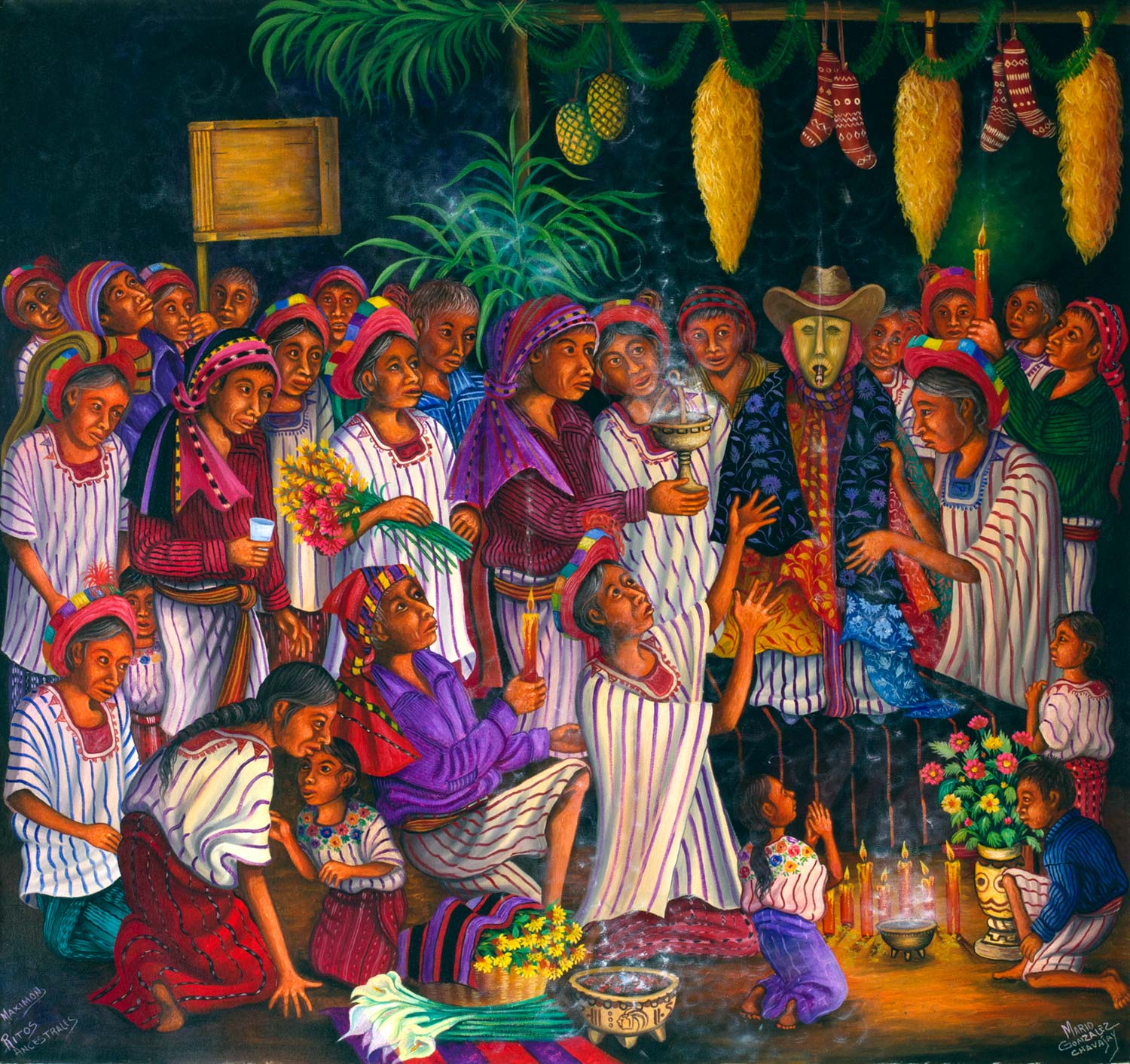The Tz’utujil Maya are a people of the Lake Atitlán basin and the southern coast, where they live today. The customs of their ancestors are still alive. One of these is the veneration of Grandfather Ma’ Ximoon, also known as Ri’jlaj Maam. (Ri’jlaj and Maam are both words for “Old Man” or “Grandfather.”) The same terms can also mean “grandson,” depending on the context. Thus, Ri’jlaj Mam is the Great Lord or the Great Grandfather.
The Ma’ Ximoon of Santiago Atitlán, however, is unique and stands apart from all others. Among the Maya towns around Lake Atitlán, Santiago Atitlán is among the most traditional, and its Maya inhabitants hold fast to the ways of their ancestors.
The Cofradía (religious brotherhood) of Santa Cruz is the caretaker of Ma’ Ximoon. The main person performing the prayers and rituals attending Ma’ Ximoon is an Ajq’iij (priest and time bearer) with the title of teleneel (bearer.) During Semana Santa, Holy Week, the teleneel’s duty is carrying Ma’ Ximoon around town on his shoulders, and on special days decorating and attending to his seat and table.
As depicted in Mario González Chavajay’s painting, the figure of Ma’ Ximoon wears the traje (traditional attire) of Santiago Atitlán, with numerous colored scarves around his neck. He wears a cowboy hat, and his mask usually has a cigar in his mouth. Few people know what his body looks like, but it is made of the wood of a tree known as Tz’ijte’ or tz’ajtel, commonly called palo de pito (whistle wood,) a tree mentioned in the Popol Wuj.
The Ri’jlaj Maam is the lord and great grandfather. It is he who brings together the dualities of the four corners of the universe. Rajawal ruuk’u’x ruwach’uleew is the heart and spirit of nature. He is associated with the vernal equinox, and the two halves of the year. The Ri’jlaj Maam is a complex authority, difficult for outsiders to understand.
Martin Prechtel, a Pueblo Indian from the U.S. trained as an Ajq’iij (time bearer) in Santiago Atitlán, explains that to preserve the old ways after the arrival of Europeans, the leaders of Santiago Atitlán created their own deities. He goes on: “The most important divinity was the Ri’jlaj Maam. He has many names and functions, but the ancient words, prayers, myths, and traditions have been preserved in his keeping. He is a diplomat deity, keeping the ancient pre-Colombian ways semi-compatible with the European mentality, which has crushed so much of indigenous America. He is the Lord of the ancient traditions of the Gods which can no longer be seen, but are remembered completely in form and prayer. Atitlán is therefore called Ruuk’u’x Ruwach’uleew, which means the heart of the world.”
During the five days of Semana Santa, Ma’ Ximoon is of central importance as the Lord of fecundity whose task is to fertilize the world by facilitating the transition of the dry season into the wet season, of which the death and reincarnation of Christ is a symbol. As the vehicle for this, during Semana Santa Ma’ Ximoon becomes Judas. This act of “conversion” represents the hybrid nature of the Tz’utujil Maya culture necessary to preserve their traditions; rather than representing the loss of their ancestor’s ways, this is a grand strategy to preserve their cultural memory in the modern day.
For the Catholic and evangelical religions, Judas’s betrayal of Jesus was the work of Satan. People following the old ways see it differently. For them, Christ would have not revealed his true nature without Judas betraying him, so they honor Judas as a vehicle for Christ’s death and resurrection.
The most important duties for the teleneel and the Cofradía of Santa Cruz occur during the five days of Semana Santa. On Monday of Holy Week, the teleneel and the texelaa’ (the porters’ wives) take Ma’ Ximoon’s clothes to the shore of the lake to be washed on three ancient sacred stones, at a certain time during the night. On Tuesday, the alguaciles (lower-ranking members) of the Cofradía de Santa Cruz set out on a two-day hike, following the ancient trade route that turned Santiago Atitlán into a hub between the highlands and the coastal lowlands, to bring fruit. On Wednesday, Ma’ Ximoon is brought to the front of the town hall, surrounded by the fruits where a ceremony with much drinking takes place. After that, Ma’ Ximoon returns to his private chapel and is hung by a rope from a pole adorned as a tree. On Good Friday, Ma’ Ximoon, as Judas, leaves the cofradía again on the back of the teleneel in a procession ending at the church atrium and in front of a large crowd, where he meets the carved figure of the crucified Christ. Then, he bows to the four directions. Having completed his mission of fertilizing the world for another year, he is quickly rushed back to the cofradía building, and hidden in the attic, to curb any further influence.


